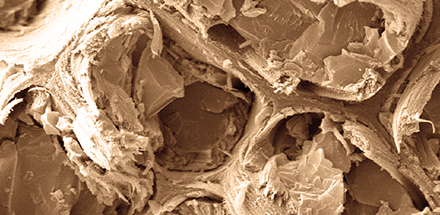There is increasing interest around the world in using timber as a lighter, more sustainable construction alternative to steel and concrete. While wood has been used in buildings for millennia, its mechanical properties have not, as yet, measured up to all modern building standards for major superstructures. This is due partly to a limited understanding of the precise structure of wood cells. Source: Timberbiz
Research, published in the journal Frontiers in Plant Science, has identified the plant Arabidopsis thaliana as a suitable model to help direct future forestry breeding programs.
Dr Jan Lyczakowski, the paper’s first author from Cambridge University’s Department of Biochemistry, who is now based at Jagiellonian University, said: “It is the molecular architecture of wood that determines its strength, but until now we didn’t know the precise molecular arrangement of cylindrical structures called macrofibrils in the wood cells. This new technique has allowed us to see the composition of the macrofibrils, and how the molecular arrangement differs between plants, and it helps us understand how this might impact on wood density and strength.”
The main building blocks of wood are the secondary walls around each wood cell, which are made of a matrix of large polymers called cellulose and hemicellulose, and impregnated with lignin.
Trees such as the giant sequoia can only achieve their vast heights because of these secondary cell walls, which provide a rigid structure around the cells in their trunks.
The team from Cambridge University’s Department of Biochemistry and Sainsbury Laboratory (SLCU) adapted low-temperature scanning electron microscopy (cryo-SEM) to image the nanoscale architecture of tree cell walls in their living state. This revealed the microscopic detail of the secondary cell wall macrofibrils, which are 1000 times narrower than the width of a human hair.
To compare different trees, they collected wood samples from spruce, gingko and poplar trees in the Cambridge University Botanic Garden. Samples were snap-frozen down to minus 200°C to preserve the cells in their live hydrated state, then coated in an ultra-thin platinum film three nanometres thick to give good visible contrast under the microscope.
The team also imaged the secondary cell walls of Arabidopsis thaliana, an annual plant widely used as the standard reference plant for genetics and molecular biology research. They found that it too had prominent macrofibril structures. This discovery means that Arabidopsis could be used as a model for further research on wood architecture.
Using a collection of Arabidopsis plants with different mutations relating to their secondary cell wall formation, the team was able to study the involvement of specific molecules in the formation and maturation of macrofibrils.
“Visualising the molecular architecture of wood allows us to investigate how changing the arrangement of certain polymers within it might alter its strength,” said Professor Paul Dupree, a co-author of the study in Cambridge’s Department of Biochemistry. “Understanding how the components of wood come together to make super strong structures is important for understanding both how plants mature, and for new materials design.”
“There is increasing interest around the world in using timber as a lighter and greener construction material,” added Dupree. “If we can increase the strength of wood, we may start seeing more major constructions moving away from steel and concrete to timber.”






